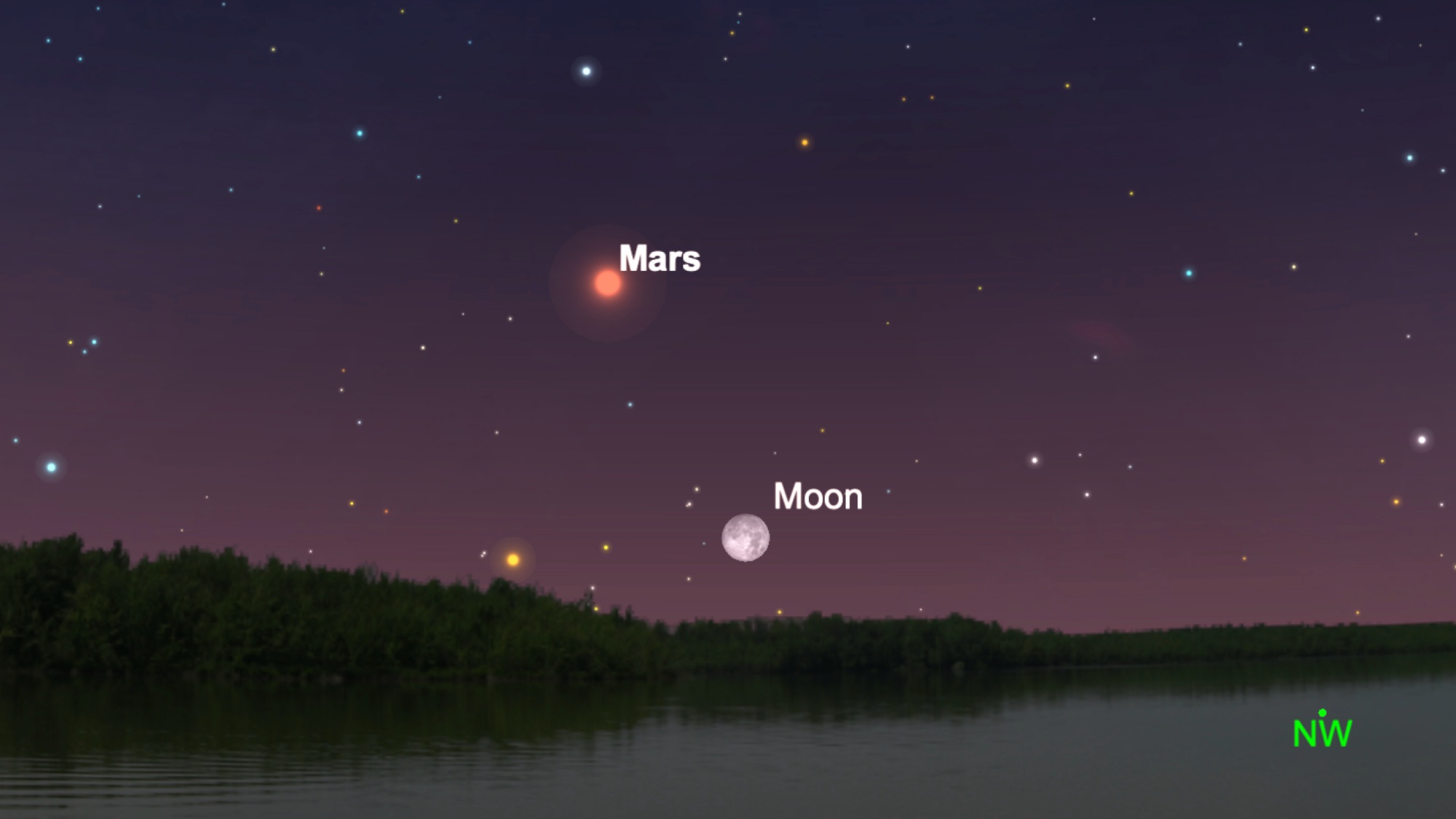See Mars at opposition join the full moon in the sky tonight (Dec. 7)
The Red Planet will rise in the east as the sun sets in the west and will appear larger and brighter over Earth throughout the night.

On the evening of Wednesday (Dec. 7) and into the early morning hours on Thursday (Dec. 8), Mars will be directly opposite the sun in the sky in an astronomical arrangement called an opposition. Mars will be in the constellation Taurus while in opposition and will be visible for most of the night reaching its highest point at around midnight local time across the globe.
Skywatchers in New York City will see the arrangement from around 4:55 p.m. EST on Dec. 7 (2135 GMT) when it raises 7 degrees over the horizon to the northeast according to In the Sky. The Red Planet will reach its highest point in the sky 74 degrees above the southern horizon, at around 11:41 p.m. EST (0441 GMT). Following this, Mars at opposition will disappear from view on Thursday morning (Dec. 8) when it sinks below 7 degrees over the northwest horizon and disappears from view at approximately 6:27 a.m. EST (1127 GMT). (Your fist's width at arm's length equals about 10 degrees in the sky.)
Tonight's instance of the Red Planet at opposition also happens to coincide with the rise of the full Cold Moon, the last full moon of 2022, as well as a lunar occultation of Mars as seen from many parts of the globe. Check out our guide on viewing times and locations to see if you can witness the occultation from where you happen to be. If you can't see the event in person, you can still watch the lunar occultation of Mars online for free, courtesy of several webcasts from observatories around the world.
Related: What time will the full moon eclipse Mars on Dec. 7?
Mars is in opposition due to the way the solar system will be arranged tonight. Mars, Earth, and the sun will be in a straight line with our planet and the Red Planet on the same side of our star. Earth will sit in the middle of Mars and the sun, allowing the planet to appear illuminated by the sun from our vantage point.
During the opposition, Mars will also make its closest approach to Earth, known as its perigee. This means it will appear both brighter and larger in the night sky than usual.


Want to get a better look at Mars at opposition? We recommend the Celestron Astro Fi 102as the top pick in our best beginner's telescope guide.
While many of the solar system's planets get somewhat brighter and larger during their close approach to our planet, the effect is at its most extreme for Mars. The Red Planet displays the largest variation in its apparent size and brightness during perigee with its angular size increasing by as much as seven times.
Get the Space.com Newsletter
Breaking space news, the latest updates on rocket launches, skywatching events and more!
This large variation in Mars' appearance is because the distance between Mars and Earth has a much larger range, from around 250 million miles (401 million kilometers) at its furthest to approximately 33.5 million miles (54 million km) at its closest. The average distance between Earth, the solar system's third planet, and Mars, the fourth planet from the sun, is around 140 million miles (225 million km).
Because Mars spends most of its time far away from us the times its orbit brings it close to our planet and opposite to the sun in the sky offer skywatchers an excellent opportunity to observe the Red Planet.
According to NASA, Mars oppositions happen about every 26 months with the Red Planet rising in the east as the sun sets in the west; following opposition, Mars then sets in the west on the morning of Dec. 8 as the sun rises in the east. Mars will appears large and bright for just a few weeks surrounding tonight's astronomical arrangement. Mars will next be at opposition in January 2025.
Though Mars at opposition will be visible with the naked eye, to see the Red Planet as anything more than a speck of light, skywatchers will need the aid of a telescope. If you need a telescope or even binoculars, make sure to read our guides for the best binoculars and the best telescopes to view Mars at opposition and other celestial spectacles. For capturing the best pictures of Mars that you can, don't miss our recommendations for the best cameras for astrophotography and best lenses for astrophotography.
Editor's Note: If you snap Mars during its opposition and would like to share it with Space.com's readers, send your photo(s), comments, and your name and location to spacephotos@space.com.
Follow us on Twitter @Spacedotcom or on Facebook.
Join our Space Forums to keep talking space on the latest missions, night sky and more! And if you have a news tip, correction or comment, let us know at: community@space.com.

Robert Lea is a science journalist in the U.K. whose articles have been published in Physics World, New Scientist, Astronomy Magazine, All About Space, Newsweek and ZME Science. He also writes about science communication for Elsevier and the European Journal of Physics. Rob holds a bachelor of science degree in physics and astronomy from the U.K.’s Open University. Follow him on Twitter @sciencef1rst.









